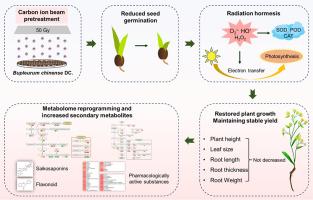Carbon ion beam-induced radiation hormesis in Bupleurum chinense DC.: Insights from growth, physiological, and metabolomic analyses for increased bioactive substances
IF 6.8
Q1 PLANT SCIENCES
引用次数: 0
Abstract
Bupleurum chinense DC (B. chinense) is an important medicinal plant widely used in Asian countries. However, the efficacy of its medicinal components has medicinal components during the domestication process from wild to cultivated lines. Studies have shown that appropriate stress, such as ionizing radiation, can promote the accumulation of metabolites in medicinal plants. Nevertheless, the effects of ionizing radiation on B. chinense remains unclear. In this study, we systematically investigated the stimulatory effect of carbon ion beams (CIB) pretreatment on the growth, physiology, and accumulation of secondary metabolites in B. chinense. Although CIB irradiation inhibited the seed germination and survival rates, by the age of 4 months, the plant height and leaf area of the irradiated group had recovered to the levels comparable to the control. The enhanced growth performance during later developmental stages may be attributed to radiation hormesis and ROS-mediated regulation in antioxidant system and the photosynthetic system. One and two years after irradiation at doses of 50 and 100 Gy, no significant differences in root biomass were observed compared to the control group. Metabolically, the content of total flavonoid, saikosaponin a and saikosaponin c were significantly increased following 50 Gy irradiation. Further metabolomic analysis revealed that intermediate metabolites in the flavonoid and terpenoid biosynthetic pathways were significantly up-regulated in the 50 Gy irradiation group. Compounds with pharmacological activity also accumulated in large quantities after irradiation. These results suggest that pretreatment with 50 Gy CIB irradiation could serve as a potential method to promote the accumulation of secondary metabolites in B. chinense. This finding provides strong support for the application of physical radiation technology to enhance the production of secondary metabolites in medicinal plants, offering new avenues for the cultivation of high-quality Chinese herbal medicines.

碳离子束诱导的柴胡辐射激效。:生物活性物质增加的生长、生理和代谢组学分析
柴胡(Bupleurum chinense DC, B. chinense)是亚洲国家广泛使用的重要药用植物。然而,其药用成分的功效在从野生品系到栽培品系的驯化过程中具有药用成分。研究表明,适当的胁迫,如电离辐射,可以促进药用植物代谢产物的积累。然而,电离辐射对中国白僵菌的影响尚不清楚。本研究系统研究了碳离子束(CIB)预处理对中国白刺生长、生理和次生代谢产物积累的刺激作用。虽然CIB辐照抑制了种子的萌发和存活率,但到4个月时,辐照组的株高和叶面积已恢复到与对照相当的水平。发育后期生长性能的提高可能与辐射激效和ros介导的抗氧化系统和光合系统的调节有关。在50 Gy和100 Gy剂量照射后1年和2年,与对照组相比,根系生物量没有显著差异。代谢方面,50 Gy辐照后,总黄酮、柴草皂苷a和柴草皂苷c含量显著升高。进一步的代谢组学分析显示,在50 Gy辐照组中,黄酮类和萜类生物合成途径的中间代谢物显著上调。具有药理活性的化合物在辐照后也大量积累。上述结果表明,50 Gy CIB辐照预处理可能是促进中国白刺次生代谢物积累的一种潜在方法。这一发现为应用物理辐射技术促进药用植物次生代谢产物的产生提供了有力的支持,为优质中草药的培育提供了新的途径。
本文章由计算机程序翻译,如有差异,请以英文原文为准。
求助全文
约1分钟内获得全文
求助全文
来源期刊

Plant Stress
PLANT SCIENCES-
CiteScore
5.20
自引率
8.00%
发文量
76
审稿时长
63 days
期刊介绍:
The journal Plant Stress deals with plant (or other photoautotrophs, such as algae, cyanobacteria and lichens) responses to abiotic and biotic stress factors that can result in limited growth and productivity. Such responses can be analyzed and described at a physiological, biochemical and molecular level. Experimental approaches/technologies aiming to improve growth and productivity with a potential for downstream validation under stress conditions will also be considered. Both fundamental and applied research manuscripts are welcome, provided that clear mechanistic hypotheses are made and descriptive approaches are avoided. In addition, high-quality review articles will also be considered, provided they follow a critical approach and stimulate thought for future research avenues.
Plant Stress welcomes high-quality manuscripts related (but not limited) to interactions between plants and:
Lack of water (drought) and excess (flooding),
Salinity stress,
Elevated temperature and/or low temperature (chilling and freezing),
Hypoxia and/or anoxia,
Mineral nutrient excess and/or deficiency,
Heavy metals and/or metalloids,
Plant priming (chemical, biological, physiological, nanomaterial, biostimulant) approaches for improved stress protection,
Viral, phytoplasma, bacterial and fungal plant-pathogen interactions.
The journal welcomes basic and applied research articles, as well as review articles and short communications. All submitted manuscripts will be subject to a thorough peer-reviewing process.
 求助内容:
求助内容: 应助结果提醒方式:
应助结果提醒方式:


